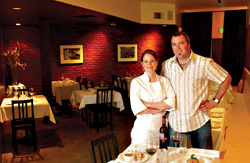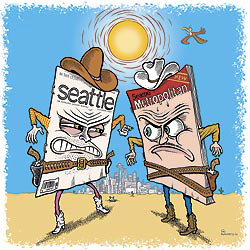Before Tim Burton ever got his hands on Charlie and the Chocolate Factory, the Woodinville-based candy company ELEGANT GOURMET, founded in 1990, was producing every one of its lollipops and candy canes (and chocolates and baked goods) by hand. The company is one of few remaining practitioners of candy-making techniques that date back to the 19th century. “We are definitely a lost art,” says founder and owner Louisa Davis. “We have revived a lot of old recipes, an old style of candy making. We’re one of three companies that I’m aware of in the country that hand-make hard candy.”
What exactly does the process entail? “Well, there’s liquid candy first,” Davis says. “There’s sugar and corn syrup, and it’s cooked in a big copper kettle, to 310 degrees. And then it’s poured out on a table, and the candy starts to cool. And at that point, it’s hand-colored, and then we divide the table, as it cools, into sections. Like, if it was a red-and-white candy cane, there would be three sections: a red section, a white section, and then the third section is the center of the candy cane.” And then the work really begins. “The red and white sections get pulled on a big meat hook, [which] incorporates air into the candy, and it makes it lighter.” No automated assembly line at Elegant Gourmet. After the workout on the meat hook, the colored sections are ready to earn their stripes. The white middle section is placed on top of the red pieces, which are then wrapped around it. Candy makers go through another labor-intensive hand-pulling step, and the candy continues to cool—but hopefully, not too quickly. Davis and her crew must watch over these final moments like candy hawks. “You’re managing the temperature,” she says, “because if it gets too cold, you throw the batch away.”
Making candy isn’t child’s play, and at Elegant Gourmet, these hands-on confectionary artisans undergo a 10-month training program before they’re able to manage all that pulling and wrapping. Part of the company’s claim to fame, besides its 19th-century process, is its vibrant use of color. (Check out the psychedelic-looking Pink Lemonade Swirl Lolli on the Web site for evidence.) Davis also specializes in designing conceptual lines of candy, which often require groundbreaking uses of sugar and she freely admits might sound a little “goofy if you’re not a foodie.” But how’s this for pioneering: Davis says the company recently produced a confection that consisted of “a marshmallow, covered with milk chocolate, then white chocolate, then rolled in sugar crystals, so they look like snowballs.” Don’t your teeth ache just reading about it?
In addition to retail sales and a long list of corporate clients (Nordstrom, Starbucks, Williams-Sonoma), weekly tours keep Davis and her 45-person staff occupied. She hopes to develop, in the next few years, a program for elementary-school students that stresses the value of science and math in making candy. 15510 Woodinville-Redmond Rd., Building E, Woodinville, 425-814-2500, www.elegantgourmet.com.







